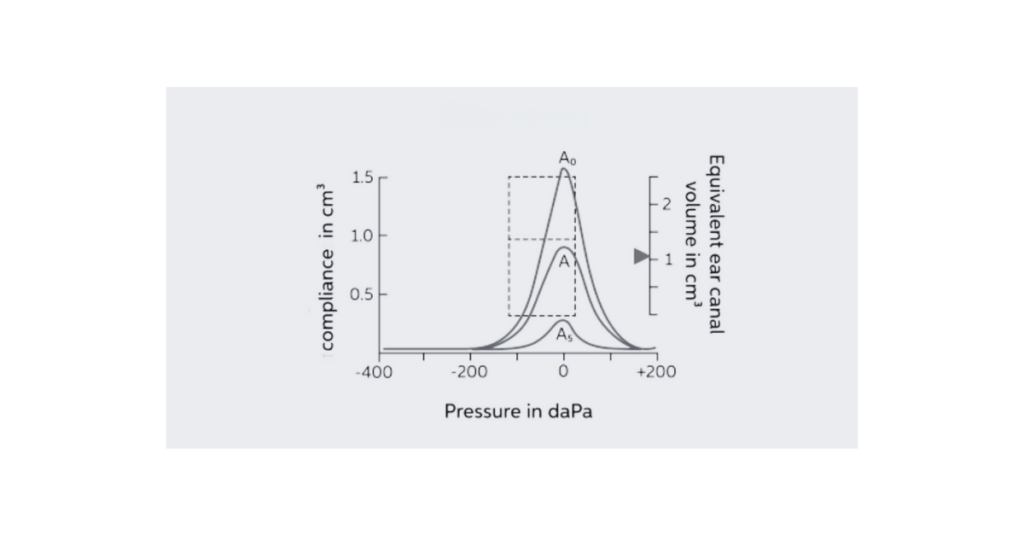If you’ve been told you need a hearing test, you may hear the word tympanometry. It sounds technical, but the test is simple and painless. Tympanometry checks how well your middle ear is working.
What is Tympanometry?
Unlike a normal hearing test, which measures how well you hear sounds, this test looks at how your eardrum moves when air pressure changes inside the ear. This movement tells your hearing specialist if the ear is healthy, blocked, or has fluid inside.
Why it matters
For many adults, especially seniors thinking about hearing aids, tympanometry can give clear answers:
- Is my hearing loss caused by a treatable middle ear problem?
- Could an infection or fluid be making my hearing worse?
- Would hearing aids work better after treatment?
The good news is that the test only takes a few minutes. It can help your hearing specialist decide the best next step – whether that’s medicine, a minor procedure, or moving forward with hearing aids.
How Tympanometry Works
During the test, a probe-type device is gently inserted into the ear canal, creating variations in air pressure. This causes the eardrum to move back and forth, allowing the tympanometer to record the response.
Tympanometry is especially useful in diagnosing conditions such as otitis media, a common middle ear infection. By assessing the middle ear’s ability to conduct sound and detect any abnormalities, tympanometry helps audiologists identify the underlying causes of ear-related symptoms.
The eustachian tube, which connects the upper part of the throat and nose with the middle ear, plays a crucial role in regulating the pressure in the middle ear. If the eustachian tube is not functioning properly, it can lead to abnormal pressure in the middle ear, affecting the movement of the tympanic membrane – also known as the ear drum.
Tympanometry provides valuable information about the middle ear’s health, allowing for accurate diagnosis and appropriate treatment.
Preparing for a Tympanometry Test
Preparing yourself for a tympanometry test is straightforward and requires a few simple steps. Here’s what you need to do:
- Inform your healthcare provider about any ear-related symptoms or concerns you may have.
- Remove any hearing aids or other devices from your ears before the test.
- Keep your outer ear clean and free from excessive earwax buildup.
- It is essential to remain still and refrain from speaking or swallowing during the test to ensure accurate results.
- If you have any questions or concerns about the test, don’t hesitate to ask your healthcare provider for clarification.
By following these steps, you can help ensure a smooth and accurate tympanometry test, providing valuable insights into your ear health.
Step-by-Step Guide Through the Tympanometry Procedure
Tympanometry is a straightforward procedure. The process involves several steps to evaluate the middle ear’s function accurately. Here’s a step-by-step guide to help you understand the process:
- Preparation: Your healthcare provider will ensure that your ear canal is clear of any obstructions, such as earwax or foreign objects.
- Insertion of the probe: A probe-type device will be gently inserted into your ear canal. It may feel a little uncomfortable, but it shouldn’t cause any pain.
- Air pressure changes: The tympanometer will generate variations in air pressure in the ear canal. These pressure changes will cause the eardrum to move back and forth.
- Measurement and recording: The tympanometer will measure the movement of the eardrum and record the response. The measurements will be displayed on a tympanogram, providing valuable information about the middle ear’s health and functionality.
- Analysis: Healthcare professionals will analyze the tympanogram, considering factors such as ear canal volume, sound energy, and the movement of the tympanic membrane, to assess the middle ear’s function and detect any abnormalities.
By following this step-by-step guide, you can gain a better understanding of the tympanometry process and its significance in assessing the health of your middle ear.
What the Different Tones and Pressures Indicate
Tympanometry results are displayed on a graph called a tympanogram, which provides information about the movement of the ear drum and the pressure in the middle ear. Different tones and pressures on the tympanogram indicate various aspects of the middle ear’s function. Here’s what they mean:
- Peak pressure: This refers to the point of maximum movement of the eardrum. It indicates the pressure at which the eardrum moves the most.
- Peak height: This represents the maximum displacement of the eardrum. It shows how much the eardrum moves in response to the pressure changes.
- Width of the curve: This indicates the width of the tympanogram curve, reflecting the compliance or stiffness of the middle ear system.
By analyzing these parameters, healthcare professionals can evaluate the middle ear’s function and identify any abnormalities or issues that may be affecting your hearing.
| Parameter | Meaning |
| Peak pressure | Indicates the maximum movement of the eardrum |
| Peak height | Represents the maximum displacement of the eardrum |
| Width of curve | Reflects the compliance or stiffness of the middle ear system |
Understanding Normal vs. Abnormal Tympanometry Results
Normal tympanometry results indicate that the middle ear is functioning within the expected range. The eardrum moves normally and the ossicles, the small bones in the middle ear that conduct sound, have normal movement.
Additionally, there is no fluid in the middle ear and the pressure is within the normal range.
Abnormal tympanometry results suggest that there may be an underlying issue with the middle ear. The eardrum may not move as expected, or the movement may be restricted. There may also be fluid present in the middle ear or abnormal pressure levels.
These abnormal results can indicate various conditions, such as fluid accumulation, scarring of the eardrum or other middle ear problems. Further evaluation and follow-up may be necessary to determine the specific cause and appropriate treatment options.
Types of Tympanograms and Their Meanings
Tympanometry results are typically represented by different types of tympanograms, each indicating a specific middle ear condition. Here are the types of tympanograms commonly encountered:
- Type A: This is considered a normal tympanogram, indicating a healthy middle ear with no abnormalities. The peak pressure, peak height, and width of the curve fall within the normal range.
- Type As: This indicates reduced compliance of the middle ear, suggesting possible stiffness or fixation of the ossicles. It may be associated with conditions such as otosclerosis.
- Type Ad: This indicates increased compliance of the middle ear, suggesting hypermobility of the ossicles. It may be associated with conditions such as a dislocated ossicle or patulous eustachian tube.
- Type B: This indicates abnormal or absent movement of the tympanic membrane. It may suggest the presence of fluid in the middle ear, a perforated eardrum, or other middle ear problems.
- Type C: This indicates negative pressure in the middle ear, suggesting dysfunction of the eustachian tube. It may be associated with conditions such as eustachian tube dysfunction or chronic otitis media.
By understanding the different types of tympanograms and their meanings, healthcare professionals can accurately diagnose middle ear problems and determine appropriate treatment options.
After the Tympanometry Test
After undergoing a tympanometry test, there are several possible scenarios depending on the results:
- Normal results: If the tympanometry results are normal, it indicates that the middle ear is functioning properly, with no abnormalities. Further follow-up tests may not be necessary unless there are specific concerns or symptoms.
- Abnormal results: If the tympanometry results are abnormal, it suggests an issue with the middle ear. Further evaluation and follow-up tests may be required to determine the specific cause and appropriate treatment options.
- Hearing loss: Tympanometry is an essential tool in diagnosing hearing loss. Abnormal tympanometry results, combined with other types of hearing tests, can help identify the cause and severity of hearing loss, facilitating appropriate treatment.
Next Steps Following Abnormal Results
After receiving abnormal results from a tympanometry test, there are several next steps that may be taken. If fluid in the middle ear is detected, it may be necessary to treat any underlying infections, such as otitis media. In some cases, a course of antibiotics may be prescribed.
Depending on the severity of the hearing loss, hearing aids may be recommended. These devices can help improve hearing and communication abilities. It is important to consult with an audiologist or hearing healthcare professional to determine the best type of hearing aid for your specific needs.
Additionally, follow-up tests may be necessary to further investigate the cause of the abnormal results. These tests may include a comprehensive hearing evaluation, additional tympanometry tests or imaging studies. It is important to address any concerns or questions with your healthcare provider and follow their recommended course of action.
Follow-Up Tests and Treatments
In some cases, abnormal tympanometry results may indicate the presence of middle ear disorders. These disorders can include scarring of the eardrum, middle ear infections, or problems with the small bones in the ear.
Depending on the specific condition, follow-up tests and treatments may be necessary.
For scarring of the eardrum, surgery may be required to repair the damage. Middle ear infections may be treated with antibiotics or other medications. Problems with the small bones in the ear may require surgical intervention to improve hearing.
In certain cases, hearing aids may be recommended to help improve hearing and communication abilities. There are various types of hearing aids, including some which are virtually invisible, and they can be customised to fit your specific needs.
Closing Thoughts
Tympanometry offers several benefits in diagnosing and monitoring ear conditions. It provides valuable information about the middle ear, including the presence of fluid, the integrity of the tympanic membrane and the function of the eustachian tube.
One of the key benefits of tympanometry is its ability to diagnose various ear conditions, such as otitis media and middle ear infections. The test can also help monitor ear health over time, particularly in individuals who are prone to fluid buildup or recurrent infections.
Tympanometry can also assess the normal pressure in the middle ear, which is important for maintaining optimal hearing. By identifying any abnormalities in middle ear pressure, healthcare professionals can provide appropriate interventions and treatments to ensure overall ear health.
If you have concerns over your hearing, or that of a loved one, why not book a free home visit hearing test to get it checked out.
Sound Hearing is a private audiologist serving the London area.


